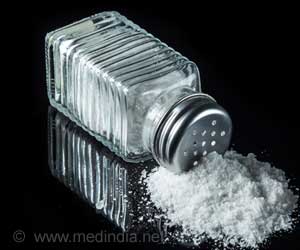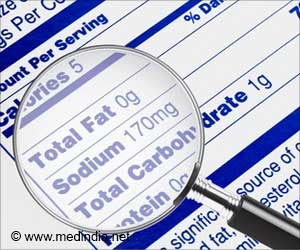Reducing the sodium content in packaged food can save lives. So, eat less salt to reduce the risk of high blood pressure, heart disease, kidney disease and stomach cancer.

‘Salt reduction can save lives: Healthy adults tend to limit sodium to less than 2,300 mg per day.’
Read More..




Read More..
Advertisement
Is too Much Salt Bad for Health
High sodium intake increases blood pressure, risk of heart disease and stroke, chronic kidney disease and stomach cancer. To reduce the incidence of these conditions, the World Health Organization (WHO) recommends reducing the population-wide average sodium intake by 30% by 2025, which limits total daily sodium intake per person to about 2 grams (g), or 2,000 milligrams (mg), per day. The U.S. Department of Agriculture’s Dietary Guidelines for Americans recommends that healthy adults limit sodium to less than 2,300 mg per day. Current daily sodium intake in the U.S. is estimated at 3,400 mg/day per person.Most sodium in people’s diets comes from processed and packaged foods. The American Heart Association estimates that 75% or more of daily sodium intake in the U.S. is from processed/packaged foods and restaurant foods. Reducing sodium in packaged foods through product reformulation programs is considered by WHO as a “best buy” to prevent diseases related to high sodium intake.
Advertisement
Foods High in Sodium
In 2021, the WHO released guidance for sodium levels in food categories that are the biggest contributors to sodium intake such as processed meats, bread and sauces. For example, the WHO benchmark for lunch meat is 540 mg of sodium per 100 g of product, and bread is 330 mg of sodium per 100 g of product. Many countries have implemented reformulation programs for processed foods; however, they may be poorly monitored and include fewer food categories than recommended by the WHO.The Australian government established a voluntary reformulation program for 27 packaged food categories. The WHO benchmarks, however, include 58 packaged food categories.
“We had previously modeled the potential impact of the Australian program,” said the study’s co-lead author Kathy Trieu, M.P.H., Ph.D., lead author of the study and senior research fellow in food policy at The George Institute for Global Health, and a senior lecturer at the University of New South Wales, both in Sydney, Australia.
“In this study, we wanted to estimate the potential number of additional premature deaths, new cases of disease and years lived with disability that may be averted with the WHO sodium benchmarks, which are above and beyond the Australian government’s sodium reformulation targets.”
Salt Reduction Saves Lives
In their previous study, Trieu and colleagues found that Australia’s plan reduced average sodium intake by 107 mg per day per person and may avert about 500 deaths, 1,900 new cases of cardiovascular disease, chronic kidney disease and stomach cancer (combined), and 7,355 disability-adjusted life years (DALYs) in Australia each year. DALYs are a measure of years of healthy life lost due to illness or premature death.They applied the same statistical model to estimate the potential impact of extending the Australian plan to include all 58 packaged food categories in the WHO benchmarks. The model used national data from 2011-2012 on sodium intake, food composition and sales for the targeted food categories. The researchers first estimated the reduction in sodium intake that may occur if the WHO targets were met. Then, using published statistics on the relationship between sodium intake and high blood pressure, they calculated the potential effect of sodium reduction on rates of cardiovascular disease and chronic kidney disease. High blood pressure is a major risk factor for both conditions.
The impact on stomach cancer was calculated using risk estimates derived from published studies of sodium and stomach cancer. The analysis determined the potential number of deaths, new cases of disease and DALYs that may be avoided by following the WHO guidance.
Need to Focus on WHO Sodium Targets
The analyses estimated that implementing the WHO sodium targets in Australia may result in:- An average of 404 mg per day reduction in sodium for adults
- Approximately 1,770 fewer deaths from cardiovascular disease, kidney disease and stomach cancer each year, with most of the impact on deaths due to avoiding deaths from cardiovascular disease (1,450 of the total)
- About 4,500 fewer new cases of cardiovascular disease, 2,050 fewer new cases of kidney disease and 350 fewer new cases of stomach cancer per year; and
- A total of 25,670 fewer DALYs from the three conditions.
Study limitations include the use of national nutrition survey data that was collected in 2011-12 and based on a single 24-hour diet recall to estimate food consumption, therefore, this data may not reflect current sodium intake. In addition, estimates of disease burden may be less accurate than estimates of more easily measured outcomes such as death. Also, there may be other ways in addition to blood pressure that sodium reduction affects cardiovascular and kidney disease.
Source-Eurekalert















